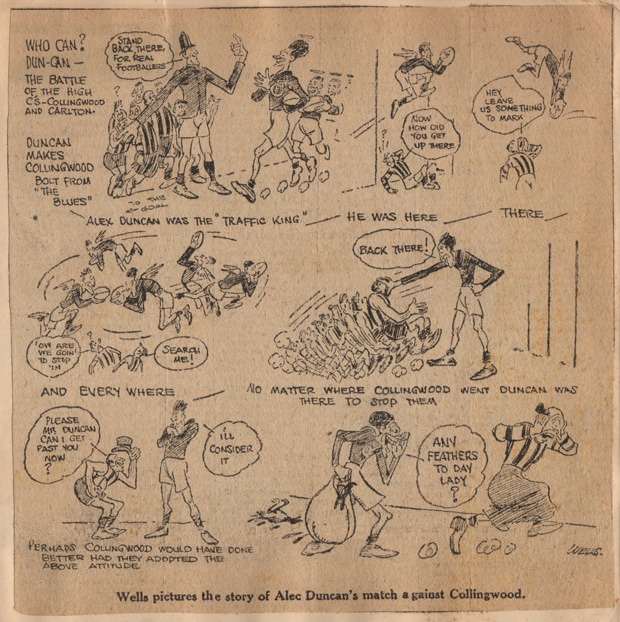On the afternoon of Saturday, June 25, 1927, against Collingwood in the most hostile of environments, Alex Duncan delivered what may well have been the greatest individual performance of any Carlton footballer before or since.
So famous was his one-man display at Victoria Park, that the contest was consigned to history with two simple words.
“Duncan’s Match”
Eighty-four years later, and in the lead-up to football’s greatest of all rivalries, “Duncan’s Match” is revisited in the following story, which was penned by Tony De Bolfo for the book ‘Out of the Blue’.
The musty newspapers of 1927 are vivid throwbacks to a time when the aviators quite literally ruled the skies. “Paris hails Lindbergh,” declares The Herald on Monday, June 27, as the American ace flew the Antarctic. “Round Australia Fliers Race Time For Record,” reports The Sun, after Kingsford-Smith and Charles Ulm set out in their Bristol aeroplane on an 850-mile non-stop jaunt from Perth to Cook.
At Victoria Park that wintry weekend, almost 33,000 aficionados of football’s two greatest rivals paid an aggregate sum of ?940 at the gate to see the extraordinary feats of another aerialist.
His name was Alex Duncan, Carlton’s seasoned centre half-back who, according to The Age’s correspondent, hauled in a staggering 33 marks for his afternoon’s work against “The Carringbush”.
John Worrall, the great Australian game’s first coach and the sporting journalist who reportedly later coined the immortal axiom “Bodyline”, said of Duncan’s showing against Collingwood that he had not seen an individual display to match it in more than 40 years of football. “If any one man saved a game, that man was Duncan,” Worrall reported for The Australasian. “His aerial work [was] simply perfection. Every effort was meritorious, while many were hair-raising. Nothing could stop him. He sailed over everybody, the certainty with which he held the ball evoking roars of approval, both from friend and foe.”
George Robert Alexander Duncan was, according to popular folklore, first invited to train with Carlton on the sayso of the local station-master on the Romsey railway. It was the station master, an avid Carlton follower, who tipped the club’s recruiters into Duncan’s series of outstanding individual performances at local level. As a result, in 1921 Duncan first appeared at Princes Park en route to forging a 10-year link built on 141 senior appearances for the old dark Navy Blues.
Duncan made an immediate impression up front, complementing the team’s acknowledged champion centre half-forward, Horrie Clover. His maiden season brought state representation for Victoria and culminated with his appearance in the 1921 Grand Final, in which Carlton fell just four points short: 4.8 (32) to Richmond’s 5.6 (36). The record books declare Duncan amongst Carlton’s best players afield in that Grand Final, but it was of no consolation to either him or his fellow leatherhunters, the likes of Paddy O’Brien and Albert Boromeo. They had made a pact to win that game to honor the memory of their late rover Lyle Downs, who had collapsed and died during an otherwise innocuous training session at Princes Park in July that year.
Though he later emerged as Carlton’s leading goalkicker (with 27 goals in 1924), Duncan ultimately assumed duties as a centre half-back. This role reversal worked to the team’s great benefit, for Duncan’s height (he stood 185cm, or 6’1” in the old measurement), superb judgment and vice-like hands ensured that he was ideally suited to the key defensive post, and his agility was the match of virtually any opponent.
When he entered that ninth round encounter at Victoria Park, he could not have known that the Collingwood team was on the cusp of football immortality. Indeed, his direct opponent, Frank Murphy, together with the likes of Harold Rumney, Charley Dibbs, the Colliers and the Coventrys, would all play their part in the Magpies’ consecutive Grand Final conquests of 1927-30?
On the eve of the game, Collingwood was sitting pretty atop the League ladder, with its great inner city foe hovering in sixth place and striving for a top four berth. In the lead-up to the match, The Argus observed: “Collingwood, which is level with Geelong for first place, and Carlton, which is one game behind its leaders, will provide the most important match, and a record crowd is expected. Both teams have been playing splendid football, and a fine exhibition should result.”
Though few statistics were tallied in those days, Duncan’s glorious showing prompted the gentlemen of the press to reach for their notepads from the outset. That the visitors prevailed, 14.11 (95) to 13.5 (83), was almost incidental given the magnitude of Duncan’s history-making display. He almost singlehandedly commandeered Carlton to a famous victory, the Blues’ first at Victoria Park since round 18, 1921.
Of Duncan’s game for the ages, one critic wrote: “His aerial work was simply perfection – some of his marks were hair-raising ones. Never was there such a brilliant performance. Nothing could stop him, and he did not make a mistake in four quarters. His beautiful drop-kicking was as flawless as his marking.”
The Argus was even more glowing. “Many former footballers and legislators described the match as the best since pre-war days, and referred to the play of Duncan, of Carlton, as the finest individual effort in the same time. As Collingwood’s Murphy was drawn to say afterwards, ‘I never saw a finer display. Duncan was magnificent, and, in addition, it was a pleasure to play against him, for he was perfectly fair all through the game.’”
And The Age correspondent, “Forward”, penned the following of “Duncan’s Match” for the Monday morning edition of June 27:
In one of the most brilliant contests ever witnessed in the history of the Australian game, the splendidly balanced Carlton combination on Saturday gained considerable prestige by administering a most decisive check to the progress of the powerful Collingwood eighteen.
[When] the gong closed the memorable struggle ... the 33,000 spectators departed for their homes all anxious to relate to their folk the story of the thrilling battle.
During the weekend, the game had been the talk of the football world, and everyone agrees that for thrills, spectacular high-marking, long-distance kicking, perfect passing, and for the fearlessness, skill, dash and cleverness of the combatants, there has been few better contests.
And outstanding in the opinion of everyone is the fact that Duncan’s meteoric marking and wonderfully dashing defence was the most sparkling individual performance of the season. In fact, one famous captain of the past yesterday stated that the great Thurgood himself had never dominated a game to such an extent as did Duncan on Saturday.
Duncan’s dazzling exhibition of spectacular high-marking, rugged defence and accurate long-distance kicking was one of the most brilliant individual efforts ever witnessed in Victorian football. “Duncan beat Collingwood,” said one Collingwood player, and others agreed that the tall man had much to do with the Magpies’ defeat. Pat O’Brien, who was an interested spectator, also praised the wonderful effort.

Duncan experienced what was most probably his greatest season in 1927. He and Melbourne’s Richard Taylor fell just one vote short of Syd Coventry in that season’s Brownlow Medal count.
Today, more than 80 years, on they still talk about “Duncan’s Match”.
Eyewitness account
The Sun, Monday, June 27, 1927
“Carlton’s Mastery over Collingwood was Complete”
FINE STRUGGLE
CARLTON’S GREAT WIN
DUNCAN, HERO
MAGPIES WERE WORN DOWN
By Gerald Brosnan
Carlton, after being practically behind all day, wore the Magpies down in the final quarter, and gained a meritorious victory by 12 points. Duncan’s remarkable individual performance in this game has perhaps never before been equalled.
In a magnificent struggle in which the high marking was superb, and the dashes desperate and electrifying, Carlton wore Collingwood down, and scored a meritorious victory by 12 points at Victoria Park.
If there was a single dissatisfied individual among the 33,000, he must indeed be hard to please, for the display, which was keen, intensely exciting, close and thrilling, ranked among the best seen for years.
I doubt if a finer individual effort than that of Duncan’s has ever been witnessed. The Carlton half-back couldn’t go wrong. With uncanny anticipation he seemed to be always in the right place, doing the correct thing, and ever in Collingwood’s way. Both his marking and kicking was wonderful.
Beveridge also, with his low, greyhound movement, his quick pick up, and clever get away gave the crowd something to wonder at, especially in the early stages.
These were the outstanding figures, but there were no duds on either side. It was a battle of giants, with the pace full on from the start. No quarter was asked, and none given, but there was nothing to cavil at in the methods.
Duncan was magnificent, standing head and shoulders above everyone else on the field.


